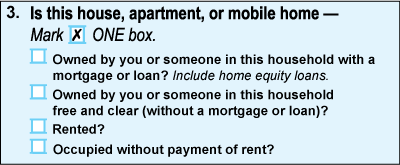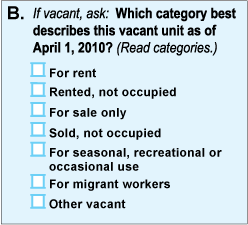Measuring Housing: Quick Facts from the 2010 Census for Indiana

A mere 10 questions were asked on the Census 2010 questionnaire.1 Of those, only one dealt with housing. That one question is limited (and users will need to turn to the American Community Survey for more detail), but it can provide us with important information about whether or not people rent or own (and whether they own outright or have a mortgage). Combined with age, race and sex data collected at the same time, we can get perspective on the population that owns or rents.

The status of the housing unit—whether it was vacant and if so, why, was only asked during a process called non-response follow-up, where census takers actually went to the non-responding unit.
What We Found
The vast majority (97.1 percent) of Indiana's population lives in housing units of some type—family homes, apartments, condominiums or mobile homes. Fewer than 200,000 people in Indiana were living in group quarters at census time (April 2010). Group quarters include facilities such as dormitories, nursing homes, halfway houses, prisons, jails and long-term care hospitals.
Our state continues to have a high percentage of people living in homes they own—either outright or with a mortgage. Seventy percent of housing units are what the Census defines as owner occupied and the majority of those have mortgages, while 20 percent are homes owned outright (see Table 1).
Table 1: Indiana's Occupied Housing Units, 2010
| Occupied housing units | 2,502,154 |
|---|---|
| Owner occupied | 69.9% |
| Owned with a mortgage or loan | 50.3% |
| Owned free and clear | 19.5% |
| Renter occupied | 30.1% |
Source: IBRC, using U.S. Census Bureau data
The Race and Ethnicity of Homeowners and Renters
The majority of housing units are owned or rented by non-Hispanic whites, which correlates with the majority of the population being white. We can also look at the data in terms of ownership or renting within each type of population, though, and begin to see the significant differences in ownership by race or ethnicity, as shown in Table 2. While non-Hispanic whites are overwhelmingly homeowners (74.2 percent), that isn't the case within the black population, where nearly 60 percent of blacks rent. Most Hispanics are homeowners, but the proportion of owners to renters is much closer—52.2 percent and 47.8 percent, respectively.
Table 2: Indiana's Homeownership by Race/Ethnicity, 2010
| Race/Ethnicity of Householder | Own | Rent |
|---|---|---|
| Not Hispanic | 70.6% | 29.4% |
| White | 74.2% | 25.8% |
| Black | 40.6% | 59.4% |
| Hispanic | 52.2% | 47.8% |
Source: IBRC, using U.S. Census Bureau data
We have also gleaned information on vacant housing, significant because of the number of foreclosures that have occurred over the past few years and coupled with the downturn in the housing market. The Census doesn't reveal information on foreclosures, but we can see from the data that a large number (nearly 10 percent) of housing units were vacant at the time of the census—nearly 300,000 units. The reasons for vacancy vary considerably, with the most prevalent being units for rent (see Table 3.)
Table 3: Indiana's Vacant Homes, 2010
| Vacancy Status | Number | Percent of Total |
|---|---|---|
| Vacant housing units | 293,387 | 100.0 |
| For rent | 93,029 | 31.7 |
| Rented, not occupied | 3,859 | 1.3 |
| For sale only | 46,410 | 15.8 |
| Sold, not occupied | 10,862 | 3.7 |
| For seasonal, recreational or occasional use | 45,571 | 15.5 |
| For migratory workers | 200 | 0.1 |
| Other vacant | 93,456 | 31.9 |
Source: IBRC, using U.S. Census Bureau data
With the release of what is called Summary File 1 (SF1) in August, significant geographic detail is available to users who want to see housing and population counts for counties, cities or towns, townships, school districts, census tracts and more. Please visit the Census topic page on STATS Indiana to learn more.
Notes
- This interactive web tool shows the actual 10 questions asked on the form: www.census.gov/2010census/about/interactive-form.php.
Carol O. Rogers
Deputy Director and Executive Editor, Indiana Business Research Center, Indiana University Kelley School of Business
